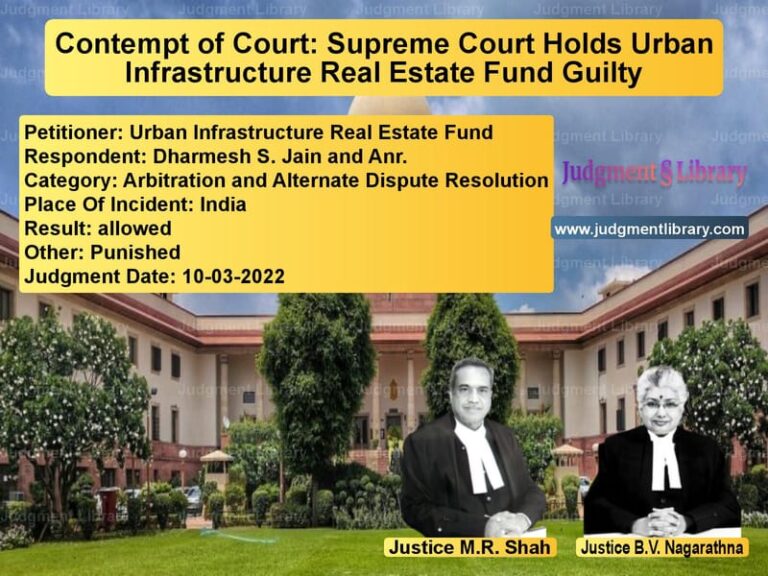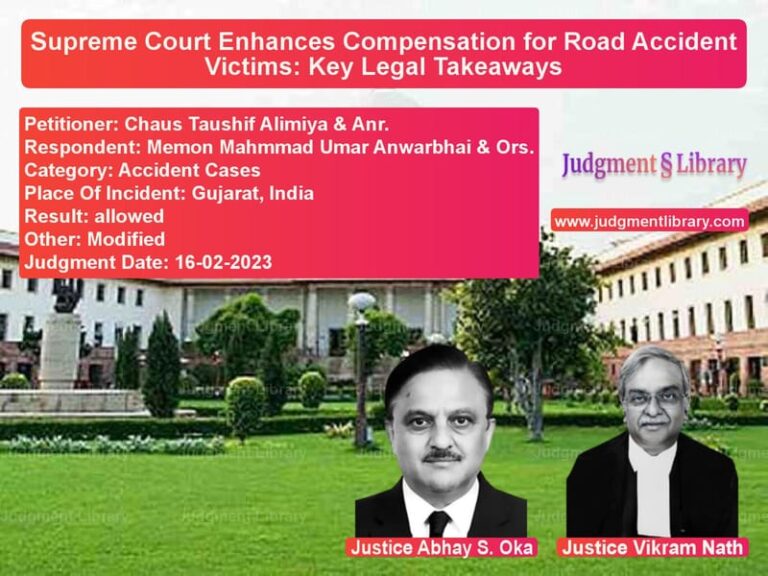Murder Conviction Upheld: Supreme Court’s Ruling on Eyewitness Credibility and Forensic Evidence
The case of Rajesh Yadav & Another vs. State of Uttar Pradesh is a crucial judgment on the admissibility of eyewitness testimony and forensic evidence in a murder trial. The Supreme Court had to determine whether the conviction of the accused under Section 302 of the Indian Penal Code (IPC) and Section 25 of the Arms Act was justified based on the evidence presented. The Court upheld the conviction, emphasizing the reliability of related eyewitnesses and forensic reports.
This judgment reinforces the principle that quality of evidence matters more than quantity and that related witnesses cannot be discredited solely on the basis of their relationship with the deceased.
Background of the Case
The case concerns a double murder that occurred on 17th September 2004 at approximately 8:15 a.m. The victims were shot multiple times by assailants traveling on motorcycles. The first information report (FIR) was lodged within an hour of the incident by PW-1, the nephew of one of the deceased.
The prosecution argued that the killings resulted from a prolonged election dispute between two groups. On the morning of the incident, the victims were waylaid and shot at close range. The postmortem examination confirmed multiple bullet injuries. The forensic science laboratory (FSL) report linked the recovered weapons to the crime scene.
Five individuals were initially charged with murder and possession of illegal arms. The High Court sentenced them to life imprisonment under Section 302 IPC but acquitted them of the attempted murder charge under Section 307 IPC. One of the accused was given a separate trial due to inadequate charges and his appeal was still pending before the High Court at the time of the Supreme Court’s decision.
Key Legal Issues
- Was the testimony of related eyewitnesses credible and sufficient to uphold the conviction?
- Did the prosecution establish a complete chain of evidence linking the accused to the crime?
- Was the forensic evidence reliable despite delays in receiving the FSL report?
- Did the trial court’s handling of eyewitness testimony and hostile witnesses meet legal standards?
Arguments Before the Supreme Court
Appellant’s Arguments
The appellants, represented by their legal counsel, contended:
- The prosecution withheld an independent, injured eyewitness (Om Prakash), raising doubts about the case.
- The two main eyewitnesses (PW-1 and PW-2) were related to the deceased and therefore had a motive to falsely implicate the accused.
- One independent eyewitness (PW-3) initially supported the prosecution’s case but later turned hostile, undermining its credibility.
- The placement of spent cartridges at the scene contradicted the prosecution’s version of how the victims were shot.
- There was an unexplained delay in receiving the forensic report, weakening its evidentiary value.
State’s Arguments
The State of Uttar Pradesh, representing the prosecution, countered:
- The trial court and High Court carefully assessed the evidence and correctly concluded that the accused were guilty.
- Merely being related to the deceased does not disqualify an eyewitness, and both PW-1 and PW-2 provided consistent, credible testimony.
- The FSL report conclusively linked the recovered weapons to the crime, supporting the prosecution’s case.
- The testimony of a hostile witness (PW-3) was still partially usable, as he confirmed key aspects of the prosecution’s version before turning hostile.
- The police had valid reasons for not producing Om Prakash as a witness, and the courts rightly considered the available evidence.
Supreme Court’s Judgment
The Supreme Court upheld the conviction, rejecting the defense’s arguments. The key findings were:
- The prosecution’s case was supported by eyewitness testimony, forensic evidence, and recoveries from the accused.
- The testimony of PW-1 and PW-2 was reliable, consistent, and corroborated by independent evidence.
- Hostile witness PW-3 had initially supported the prosecution, and his testimony was partially admissible.
- The accused failed to provide a plausible explanation under Section 313 CrPC, despite being confronted with incriminating evidence.
- The forensic report delay did not affect its credibility, as the evidence was handled according to procedure.
The Supreme Court observed:
“The evidence of related witnesses cannot be discarded merely on account of their relationship with the deceased, particularly when their testimonies are cogent, consistent, and corroborated by other material on record.”
Key Observations from the Judgment
- Credibility of Related Witnesses: Family members who witness a crime can be reliable witnesses if their testimony is consistent and corroborated by other evidence.
- Forensic Evidence: A delay in the FSL report does not automatically discredit forensic findings if the chain of custody is intact.
- Hostile Witnesses: Even if a witness turns hostile, the portions of their testimony that support the prosecution’s case remain admissible.
- Burden on the Accused: When confronted with strong evidence, the accused must provide an explanation during their statement under Section 313 CrPC.
- Admissibility of Circumstantial Evidence: A conviction can be based on circumstantial evidence if it forms a complete and unbroken chain pointing to the accused’s guilt.
Impact of the Judgment
This judgment has several important implications:
- For Criminal Law: Reinforces the principle that related witnesses can be reliable if their testimony is corroborated.
- For Prosecution Strategy: Highlights the importance of securing forensic reports on time but affirms that delays do not always weaken the prosecution’s case.
- For Defendants: Emphasizes that merely questioning witness reliability without providing a counter-explanation is insufficient for acquittal.
- For Trial Courts: Sets a precedent for handling hostile witnesses and forensic delays while ensuring a fair trial.
Conclusion
The Supreme Court’s ruling in Rajesh Yadav & Another vs. State of Uttar Pradesh is a landmark decision on the admissibility of eyewitness testimony and forensic evidence. The judgment underscores that courts must assess witness credibility based on the quality of their testimony rather than their relationship with the victim.
This ruling serves as a strong reminder that legal standards of proof must be met in all criminal cases, ensuring that convictions are based on concrete evidence rather than mere suspicion.
Petitioner Name: Rajesh Yadav & Another.Respondent Name: State of Uttar Pradesh.Judgment By: Justice M.M. Sundresh, Justice Sanjay Kishan Kaul.Place Of Incident: Uttar Pradesh.Judgment Date: 04-02-2022.
Don’t miss out on the full details! Download the complete judgment in PDF format below and gain valuable insights instantly!
Download Judgment: rajesh-yadav-&-anoth-vs-state-of-uttar-prade-supreme-court-of-india-judgment-dated-04-02-2022.pdf
Directly Download Judgment: Directly download this Judgment
See all petitions in Murder Cases
See all petitions in Judgment by M.M. Sundresh
See all petitions in Judgment by Sanjay Kishan Kaul
See all petitions in dismissed
See all petitions in supreme court of India judgments February 2022
See all petitions in 2022 judgments
See all posts in Criminal Cases Category
See all allowed petitions in Criminal Cases Category
See all Dismissed petitions in Criminal Cases Category
See all partially allowed petitions in Criminal Cases Category







